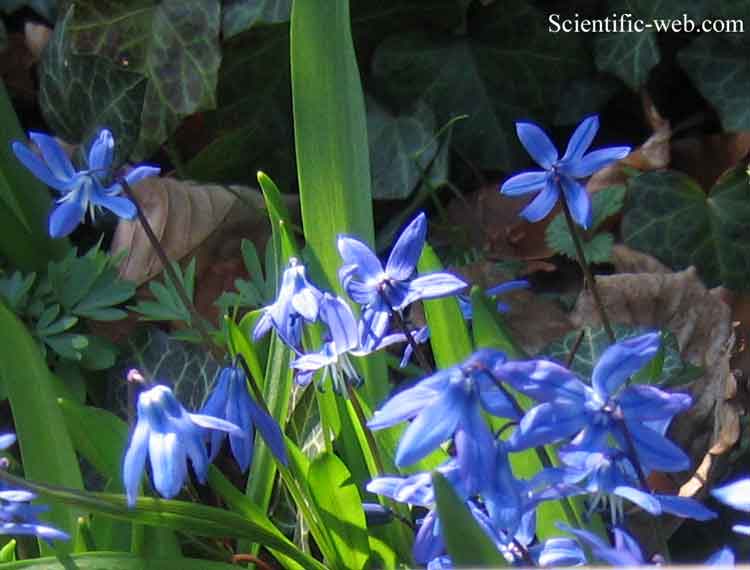
Scilla siberica, Photo: Michael Lahanas
Classification System: APG IV
Superregnum: Eukaryota
Regnum: Plantae
Cladus: Angiosperms
Cladus: Monocots
Ordo: Asparagales
Familia: Asparagaceae
Subfamilia: Scilloideae
Tribus: Hyacintheae
Subtribus: Hyacinthinae
Genus: Scilla
Species: Scilla siberica
Subspecies: S. s. subsp. armena – S. s. subsp. caucasica – S. s. subsp. otschiauriae – S. s. subsp. siberica
Name
Scilla siberica Andrews, 1804.
Synonyms
Homotypic
Othocallis siberica (Andrews) Speta, Phyton (Horn) 38: 113 (1998).
Distribution
Native distribution areas:
Continental: Asie
Regional: Western
Krym to NW. Iran
References: Brummitt, R.K. 2001. TDWG – World Geographical Scheme for Recording Plant Distributions, 2nd Edition
References
Andrews, H.C., 1804. Bot. Repos. 6: t. 365
Links
Govaerts, R. et al. 2019. Scilla siberica in World Checklist of Selected Plant Families. The Board of Trustees of the Royal Botanic Gardens, Kew. Published on the internet. Accessed: 2019 Feb. 01. Reference page.
International Plant Names Index. 2019. Scilla siberica. Published online. Accessed: Feb. 01 2019.
The Plant List 2013. Scilla siberica in The Plant List Version 1.1. Published on the internet. Accessed: 2019 Feb. 01.
Tropicos.org 2019. Scilla siberica. Missouri Botanical Garden. Published on the internet. Accessed: 2019 Feb. 01.
Vernacular names
Deutsch: Sibirischer Blaustern
English: Siberian squill
suomi: Idänsinililja
français: Scille de Sibérie
lietuvių: Sibirinė scylė
Nederlands: Oosterse sterhyacint
polski: Cebulica syberyjska
Scilla siberica, the Siberian squill or wood squill, is a species of flowering plant in the family Asparagaceae, native to southwestern Russia, the Caucasus, and Turkey. Despite its name, it is not native to Siberia.
Description
Flower
Growing to 10–20 cm (4–8 in) tall by 5 cm (2 in) wide, it is a bulbous perennial, with two to four strap-shaped leaves appearing in early spring, at the same time as the nodding, blue, bell-shaped flowers.[1]
The flowers have six tepals and six stamens, and are arranged singly or in racemes of two or three. Petals may be reflexed to the horizontal when sunlight is bright, but are more often cup-shaped. The flowers are usually blue, but those of Scilla siberica var. alba are white. The stamens of Scilla are separate, unlike those of the related genus Puschkinia, which are fused into a tube. The pollen is dark blue.
After flowering, the flower stems become limp as capsules (pods) mature. At maturity, the capsules become purple and split open, releasing small, dark brown seeds. When the seeds are mature, the leaves wither and the plant goes dormant until the next spring.
The seedlings are hollow-leaved.
Cultivation
S. siberica is cultivated for its bluebell-like flowers. It naturalizes rapidly from seed. At 15 cm (5.9 in), it is suitable for planting in grass, and will spread by seed to form large colonies that go dormant by the time grass needs to be mowed. In the Midwestern United States it is becoming invasive in some situations.[2]
This plant has gained the Royal Horticultural Society's Award of Garden Merit.[3][4]
References
RHS A-Z encyclopedia of garden plants. United Kingdom: Dorling Kindersley. 2008. p. 1136. ISBN 978-1405332965.
Chayka, Katy; Dziuk, Peter (2016). "Scilla siberica (Siberian Squill)". Minnesota Wildflowers.
"RHS Plant Selector - Scilla siberica". Retrieved 5 March 2021.
"AGM Plants - Ornamental" (PDF). Royal Horticultural Society. July 2017. p. 96. Retrieved 6 November 2018.
Retrieved from "http://en.wikipedia.org/"
All text is available under the terms of the GNU Free Documentation License

